Alice’s Adventures on Film
 Tatiana's adventures inside a sandwich boardOne of my favourite childhood books was Lewis Carroll’s Alice in Wonderland. So I was very much looking forward to seeing the Wonderland exhibition at the Australian Centre of the Moving Image (ACMI), which explores the many adventures of Carroll’s famous story on film.
Tatiana's adventures inside a sandwich boardOne of my favourite childhood books was Lewis Carroll’s Alice in Wonderland. So I was very much looking forward to seeing the Wonderland exhibition at the Australian Centre of the Moving Image (ACMI), which explores the many adventures of Carroll’s famous story on film.
 The disorienting mirrored Hallway of Doors
The disorienting mirrored Hallway of Doors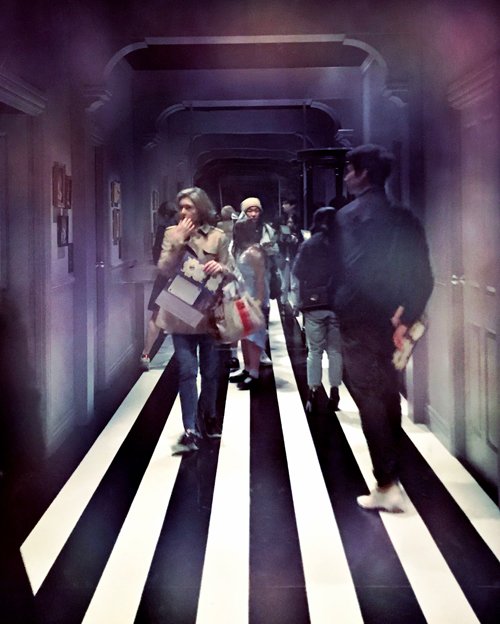 Looking through the two-way mirror into the Hallway of DoorsBeginning with the Hallway of Doors (enter by the smallest door, no matter how old you are), is a series of fantastical rooms, with names such as ‘The Pool of Tears’, ‘Looking Glass House’ and ‘A Mad Tea Party’. On show is charming footage from the late nineteenth century to the multitude of iterations produced in the century since, as well as a plethora of other material such as Charles Dodgson’s original concept drawings, magic lantern projections, vintage posters, animation cels, puppets, props and costumes.
Looking through the two-way mirror into the Hallway of DoorsBeginning with the Hallway of Doors (enter by the smallest door, no matter how old you are), is a series of fantastical rooms, with names such as ‘The Pool of Tears’, ‘Looking Glass House’ and ‘A Mad Tea Party’. On show is charming footage from the late nineteenth century to the multitude of iterations produced in the century since, as well as a plethora of other material such as Charles Dodgson’s original concept drawings, magic lantern projections, vintage posters, animation cels, puppets, props and costumes.
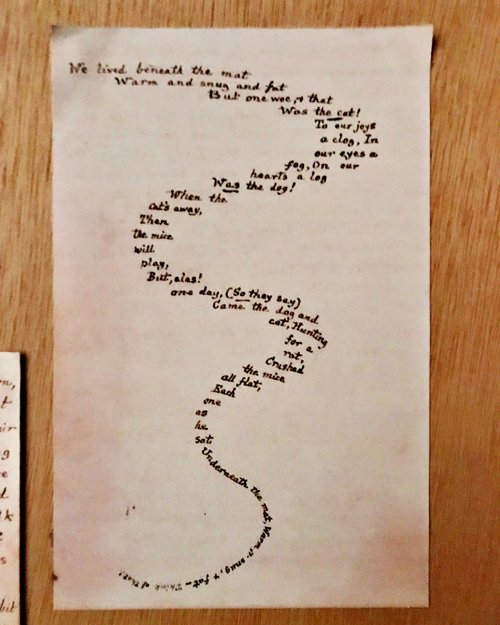 This was always my favourite page in the book when I was very little, so I was thrilled to see Charles Dodgson's original drawing, c1862–64The exhibition is immersive from the get go. On entrance, each attendee is given an ‘enchanted Lost Map of Wonderland’ that unlocks additional surprises with the aid of digital scanners in different rooms of the exhibition – if you could get past the kids hovering over the scanners.
This was always my favourite page in the book when I was very little, so I was thrilled to see Charles Dodgson's original drawing, c1862–64The exhibition is immersive from the get go. On entrance, each attendee is given an ‘enchanted Lost Map of Wonderland’ that unlocks additional surprises with the aid of digital scanners in different rooms of the exhibition – if you could get past the kids hovering over the scanners.
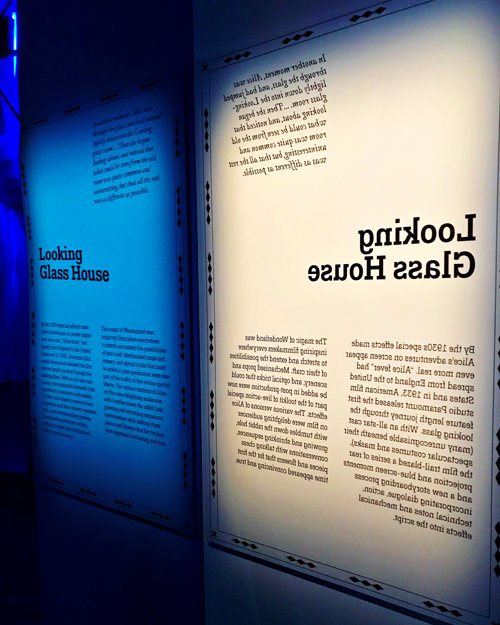 Looking Glass House; the exhibition's curation is thoughtful and thorough, and the design is clever and entertaining for young and old
Looking Glass House; the exhibition's curation is thoughtful and thorough, and the design is clever and entertaining for young and old 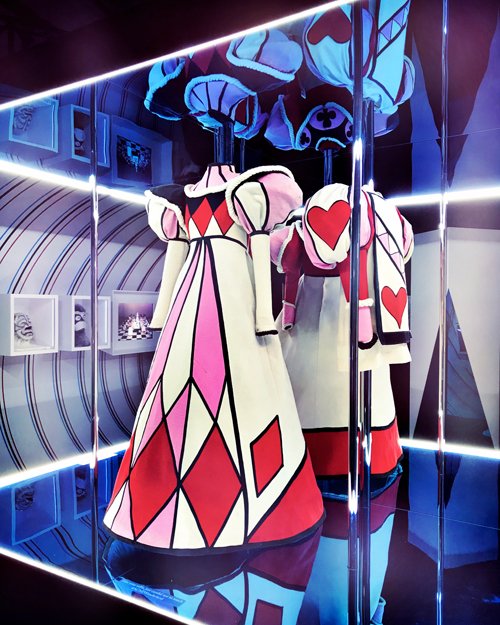 Queen's costumes in Looking Glass HouseThere are also several video installations, and my favourite was at the end, a montage of footage from film, television and advertising showcasing how the story of Alice has entered and utterly saturated popular culture to the present day. I could not help picturing how astonished and gratified Dodgson would be if he could see how far in time and space his story has reached.
Queen's costumes in Looking Glass HouseThere are also several video installations, and my favourite was at the end, a montage of footage from film, television and advertising showcasing how the story of Alice has entered and utterly saturated popular culture to the present day. I could not help picturing how astonished and gratified Dodgson would be if he could see how far in time and space his story has reached.
If you are in Melbourne, the exhibition is running at ACMI every day of the week until 7 October, and is a must-see.
 Clocks
Clocks Inside the video installation of A Mad Hatter's Tea Party
Inside the video installation of A Mad Hatter's Tea Party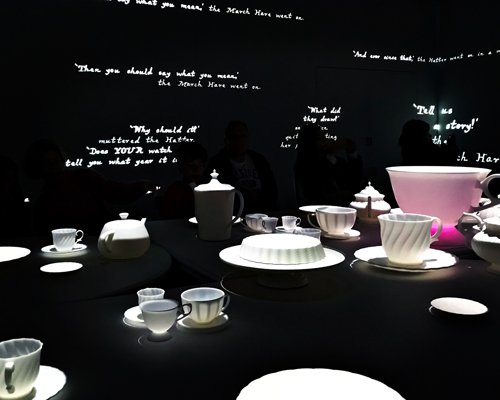 Inside the video installation of A Mad Hatter's Tea Party
Inside the video installation of A Mad Hatter's Tea Party
Layering Dreams
 Always Inside Your Dreams; collage, found paper 240mm (w) x 350mm (h)Last year I took part in a group exhibition called Read What You Look At, at Brunswick Street Gallery in Fitzroy, Melbourne. Funnily, I hadn’t actually planned for it, but had seen a call for applications in the newsletter I receive from the gallery and thought the theme was singularly appropriate for one stream of my fine arts practice.
Always Inside Your Dreams; collage, found paper 240mm (w) x 350mm (h)Last year I took part in a group exhibition called Read What You Look At, at Brunswick Street Gallery in Fitzroy, Melbourne. Funnily, I hadn’t actually planned for it, but had seen a call for applications in the newsletter I receive from the gallery and thought the theme was singularly appropriate for one stream of my fine arts practice.
I have been working on what I call my ‘random poems’ for many years – ever since I finished art college (a frighteningly long time ago) – and they have developed quite a lot over the years. Some of them are traditional hard copy collages, assembled on antique and vintage paper dating from the 1860s–1950s, and others are original digital artworks that combine collage with ink on the same paper backgrounds.
 Labours With Ancient Goddess; original digital artwork; 192mm (w) x 321mm (h)Originally they were all traditional collages, but as I started working with these priceless pieces of crumbling ephemera, I was terrified of ruining or disintegrating them with real ink, so I started experimenting with digital ink. (Some viewers of the exhibition thought it was real ink, so I can plume myself on my success there!) Of course I have to scan everything in, which is a time-consuming although ultimately pleasurable process. But there is still a real charm in the haphazard and inappropriate sizing of the words in the hard copy collages, where conjunctions sometimes shout louder than nouns or adjectives.
Labours With Ancient Goddess; original digital artwork; 192mm (w) x 321mm (h)Originally they were all traditional collages, but as I started working with these priceless pieces of crumbling ephemera, I was terrified of ruining or disintegrating them with real ink, so I started experimenting with digital ink. (Some viewers of the exhibition thought it was real ink, so I can plume myself on my success there!) Of course I have to scan everything in, which is a time-consuming although ultimately pleasurable process. But there is still a real charm in the haphazard and inappropriate sizing of the words in the hard copy collages, where conjunctions sometimes shout louder than nouns or adjectives.
Along the way I also started playing with the effect of turning the cut paper images a stark black and white, for more impact and as a contrast to the coloured letters, and splashes of ink.
Read the original Artist’s Statement on Layering Dreams, or view the gallery.
Hanging Poems
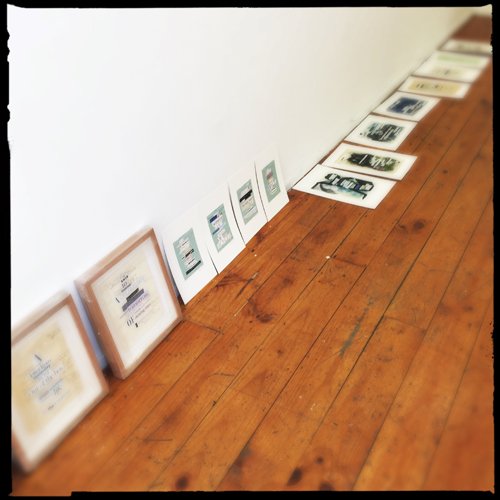 Getting ready to hangLast Thursday night I hung my exhibition at Brunswick Street Gallery. This is only my second group exhibition, and the first time I hung my own work. The method is pretty easy, and it was very satisfying to complete the task. Seeing how many pieces I had (I had originally intended to hang them all in two rows, and was prepared to pull some if it was too crowded) the curator generously allowed me to take up more space than originally allocated, which was fantastic.
Getting ready to hangLast Thursday night I hung my exhibition at Brunswick Street Gallery. This is only my second group exhibition, and the first time I hung my own work. The method is pretty easy, and it was very satisfying to complete the task. Seeing how many pieces I had (I had originally intended to hang them all in two rows, and was prepared to pull some if it was too crowded) the curator generously allowed me to take up more space than originally allocated, which was fantastic.
 Prints pinned
Prints pinned
The works were printed by Karl at Lantern Printing, on cotton rag archival paper using archival pigment inks. They came up beautifully, and the crumpled antique papers look so realistic and three-dimensional. Two originals were float-mounted in oak frames, by Leigh at Auguste Clown Gallery.
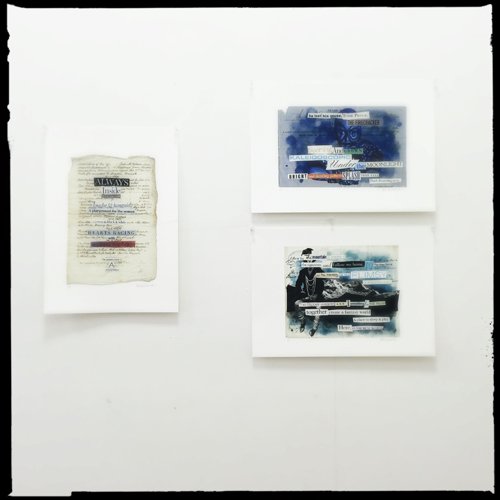 Works on exhibit include prints of hard copy originals, and prints of entirely digital artworks Opening night was on Friday, and unfortunately I was far too busy talking to guests to remember to take any photos – tsk! It was a fun evening, despite a few nerves at the start. I was hoping to overhear viewers’ responses, but alas, again, too busy talking to eavesdrop!
Works on exhibit include prints of hard copy originals, and prints of entirely digital artworks Opening night was on Friday, and unfortunately I was far too busy talking to guests to remember to take any photos – tsk! It was a fun evening, despite a few nerves at the start. I was hoping to overhear viewers’ responses, but alas, again, too busy talking to eavesdrop!
 Frames hung (not without errors prior to success!)At the conclusion of the show (two weeks from now), I will create an online gallery here for viewing. Most of the pieces on show are prints of traditional (hard copy) collages, but you can check out my digital pieces in the Random Poetry galleries.
Frames hung (not without errors prior to success!)At the conclusion of the show (two weeks from now), I will create an online gallery here for viewing. Most of the pieces on show are prints of traditional (hard copy) collages, but you can check out my digital pieces in the Random Poetry galleries.
 The works are printed on cotton rag archival paper
The works are printed on cotton rag archival paper
Layering Dreams
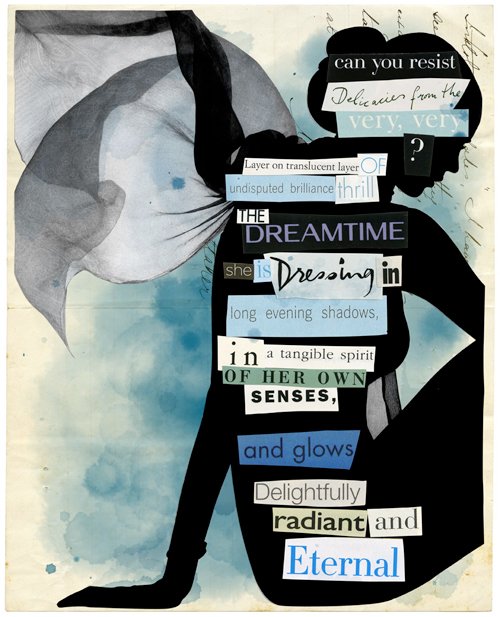 I am excited to share the news that I am taking part in a group exhibition at Brunswick Street Gallery called Read What You Look At, which opens this Friday night, and runs for two weeks.
I am excited to share the news that I am taking part in a group exhibition at Brunswick Street Gallery called Read What You Look At, which opens this Friday night, and runs for two weeks.
Although it is not my first group exhibition, it is the biggest one I’m showing in, with fourteen pieces of my ‘random poetry’ mixed-media collages on view. The series is entitled Layering Dreams, and is – you guessed it – all about dreams, sleeping, and waking.
Here is an abridged version of my artist’s statement:
From a very young age, I was captivated with telling stories through both words and pictures, often drawing and writing on found paper. At art college after studying the Dadaists, I became interested in writing poetry by reassembling random words. Recycling my magazine collection, I created a pool from which I could pull words to compile into ‘random poems’.
Always interested in dreams, and the surrealism intertwined with hidden meanings, this method of writing poetry appealed to me. Naturally, I choose words that I find appealing, but sometimes I deliberately choose ones that I don’t. This strange combination contributes to the elusive mood of Layering Dreams, often with unexpected results.
 Sometimes a poem just starts with two or three words, and I slowly build on those. The poems are engaging and easy to read not only because of their brevity, but because of how they look. The fonts and colours culled from so many different sources interact with one another visually, encouraging the viewer to also ‘look at what they read’.
Sometimes a poem just starts with two or three words, and I slowly build on those. The poems are engaging and easy to read not only because of their brevity, but because of how they look. The fonts and colours culled from so many different sources interact with one another visually, encouraging the viewer to also ‘look at what they read’.
Returning to my roots of acquiring used paper (I’d pinch my sisters’ papers from their school folders!), I’ve sourced antique papers from the late nineteenth century to the 1950s, to use as supports for the collages. As well as traditional (hard copy) collages using only words, I also create digital works, combining scanned words and images cut from magazines with digital ink.
These many layers of ephemera, words, and pictures combine to evoke the otherworldly nature of dreams.
If you happen to be in Melbourne, I’d love for you to come and check them out in person!
Father of Fashion Photography – Edward Steichen
 Model Marion Morehouse in a bouffant dress and actress Helen Lyons in a long sleeve dress by Kargère, 1926Art Deco fashion and photography – two loves of mine – meet gloriously in the National Gallery of Victoria’s exhibition Edward Steichen & Art Deco Fashion, which comprises over two hundred photographs and over thirty garments.
Model Marion Morehouse in a bouffant dress and actress Helen Lyons in a long sleeve dress by Kargère, 1926Art Deco fashion and photography – two loves of mine – meet gloriously in the National Gallery of Victoria’s exhibition Edward Steichen & Art Deco Fashion, which comprises over two hundred photographs and over thirty garments.
Edward Steichen (1879–1973), an American photographer born in Luxembourg, bought his first camera in 1895 at 16 out of curiosity: a secondhand Kodak box ‘detective’ camera. By 1903, until 1917, he was the most frequently featured photographer in the groundbreaking magazine Camera Work. Steichen’s photographs of landscapes and portraits hover between ethereal beauty and sculptural studies rendered in light and shade, though this exhibition focuses on his work in fashion, which had its inception in 1911.
 On George Bahers yacht: June Cox wearing unidentified fashion; E. Vogt wearing fashion by Chanel and a hat by Reboux; Lee Miller wearing a dress by Mae and Hattie Green and a scarf by Chanel; Hannah Lee Sherman wearing unidentified fashion, 1928
On George Bahers yacht: June Cox wearing unidentified fashion; E. Vogt wearing fashion by Chanel and a hat by Reboux; Lee Miller wearing a dress by Mae and Hattie Green and a scarf by Chanel; Hannah Lee Sherman wearing unidentified fashion, 1928 Actress Carlotta Monterey wearing a diamond head bandeau by Cartier, and a white ermine wrap with a white fox collar, 1924Steichen was encouraged by Lucien Vogel, the publisher of Jardin des Modes and La Gazette du Bon Ton, to promote fashion as a fine art through the use of photography. His subsequent photos of Paul Poiret’s gowns for the magazine Art et Décoration are regarded as the first modern fashion photographs ever published – he went on to become the chief photographer for Vogue and Vanity Fair. His work turned fashion photography on its head, and influenced generations of photographers after him.
Actress Carlotta Monterey wearing a diamond head bandeau by Cartier, and a white ermine wrap with a white fox collar, 1924Steichen was encouraged by Lucien Vogel, the publisher of Jardin des Modes and La Gazette du Bon Ton, to promote fashion as a fine art through the use of photography. His subsequent photos of Paul Poiret’s gowns for the magazine Art et Décoration are regarded as the first modern fashion photographs ever published – he went on to become the chief photographer for Vogue and Vanity Fair. His work turned fashion photography on its head, and influenced generations of photographers after him.
 Model Marion Morehouse (left) and unidentified model wearing dresses by Vionnet, 1930The graceful, flowing lines of the fashion of that era between the wars encapsulate sartorial elegance for me, and many of the garments of that time (especially those on the more minimalist side) still look effortless and modern today, nearly a hundred years later. The garments chosen to accompany Steichen’s visionary pictures are suberb; perfectly curated; and can only make one gasp and marvel at the imaginative designs and construction; at the incredible detail of decorative beading. They bring Steichen’s photographs into brilliant life.
Model Marion Morehouse (left) and unidentified model wearing dresses by Vionnet, 1930The graceful, flowing lines of the fashion of that era between the wars encapsulate sartorial elegance for me, and many of the garments of that time (especially those on the more minimalist side) still look effortless and modern today, nearly a hundred years later. The garments chosen to accompany Steichen’s visionary pictures are suberb; perfectly curated; and can only make one gasp and marvel at the imaginative designs and construction; at the incredible detail of decorative beading. They bring Steichen’s photographs into brilliant life.
 Model wearing a shawl of crepe de chine painted by Russian artists, 1924
Model wearing a shawl of crepe de chine painted by Russian artists, 1924 Princess Nathalie Paley wearing sandals by Shoecraft, 1934There is also a short documentary film in the exhibition showing Steichen working in his studio (complete with a gaggle of editorial onlookers), giving a fascinating insight into the working methods of one of the first fashion photographers of the twentieth century. One cannot be but struck how very different it was from today, how much effort was expended to achieve certain effects, and how we take for granted what is possible today. And yet in spite of the limitations, Steichen’s entire oeuvre of photography is sublimely beautiful and must still remain amongst the greatest works in the history of photography.
Princess Nathalie Paley wearing sandals by Shoecraft, 1934There is also a short documentary film in the exhibition showing Steichen working in his studio (complete with a gaggle of editorial onlookers), giving a fascinating insight into the working methods of one of the first fashion photographers of the twentieth century. One cannot be but struck how very different it was from today, how much effort was expended to achieve certain effects, and how we take for granted what is possible today. And yet in spite of the limitations, Steichen’s entire oeuvre of photography is sublimely beautiful and must still remain amongst the greatest works in the history of photography.
The exhibition runs until March 2. I might even go again.
 Actress Gloria Swanson, 1924
Actress Gloria Swanson, 1924 Actress Alice Brady dressed for the play Sour Grapes, 1926
Actress Alice Brady dressed for the play Sour Grapes, 1926 Actress Marlene Dietrich, 1934
Actress Marlene Dietrich, 1934 Actor Gary Cooper, 1930
Actor Gary Cooper, 1930


